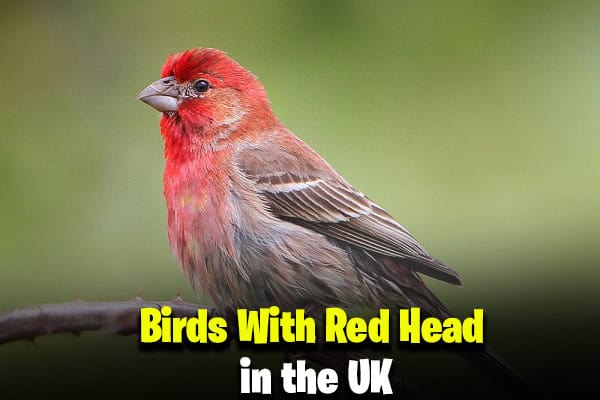9 Types Of Finches in Michigan (ID Guide With Photos)
Did you know that over 50 species of finches live in Michigan? Nine of them are found in Michigan. These colorful and interesting birds make Michigan a great place for birdwatching.
We will examine the special traits and behaviours of these Michigan finches, which will help us improve our identification of birds.
Our guide will show you the world of finches in Michigan, with photos to help you identify them. We’ll also talk about where they live and how they eat, which will help us love these beautiful birds even more.
Overview of Finch Habitats
Finches live in many places, showing how adaptable they are. In Michigan, they can be found in both natural and urban areas, demonstrating their ability to survive in different environments.
Natural Habitats for Finches
In Michigan, finches live in areas around the Great Lakes. These places have lots of food and places to nest. Natural habitats include:
- Forests
- Open woodlands
- Grasslands
- Wetlands
Each habitat supports different finch species all year. This makes Michigan great for watching their different behaviors.
Urban and Suburban Adaptations
Finches also live in cities and suburbs. Parks, gardens, and homes are their new habitats. They can find food in many places. Here are some places to see finches in cities:
- Community gardens
- Bird feeders in backyards
- Public parks
- Street trees and shrubs
Seeing finches in natural and urban areas shows their ability to adapt. It also makes our ecosystems richer.
1. House Finch
- Scientific Name: Haemorhous mexicanus
- Size: 14–18 cm (5.5–7 in)
- Weight: 16–32 g (0.56–1.13 oz)
- Lifespan: Up to 11 years
- Diet: Seeds, fruits, flowers
The House Finch adds charm and color to our gardens and parks in Michigan. Knowing how to tell males from females is key. These birds are common in both cities and the countryside and are loved by bird watchers and casual observers.

Identification Features
The House Finch has unique traits for identification. Males have bright red on their heads and chests against grey-brown bodies. Females are brown all over, helping them blend in. Important features include:
- Size: About 5 to 6 inches long.
- Bill: Short and conical, perfect for eating seeds.
- Wings: Notched and broad, with streaks on their sides.
Feeding Habits and Diet
House Finches love seeds, berries, and grains. They visit backyard feeders and gardens for sunflower seeds and birdseed. Their diet includes:
| Food Type | Examples |
|---|---|
| Seeds | Sunflower seeds, millet, and safflower seeds |
| Berries | Wild berries and garden fruits |
| Grains | Corn, oats, and various birdseed mixtures |
2. Purple Finch
- Scientific Name: Haemorhous purpureus
- Size: 16–18 cm (6.3–7.1 in)
- Weight: 18–27 g (0.63–0.95 oz)
- Lifespan: Up to 10 years
- Diet: Seeds, fruits, insects
The Purple Finch is a striking bird many birdwatchers in Michigan want to see. We’ll look at what makes it special. Knowing these traits helps us spot finches better, making birdwatching more fun.

Distinctive Characteristics
The male Purple Finch is bright raspberry-red, which is not only pretty but also helps us tell it apart from other finches. The female has a brown and streaked look, adding variety to the species.
Purple Finches live in northern forests in Michigan. They like areas with lots of shrubs for nesting. This keeps them safe from predators and bad weather.
They eat different things at different times. In summer, they eat seeds, flowers, and insects. In winter, they prefer berries from shrubs and trees.
Feeding these finches in our yards can bring them closer. Using feeders with sunflower seeds or thistle can attract them all year. By knowing what they like, we can make our yards welcoming to Purple Finches.
3. Common Redpoll
- Scientific Name: Acanthis flammea
- Size: 12–14 cm (4.7–5.5 in)
- Weight: 14–18 g (0.49–0.63 oz)
- Lifespan: Up to 5 years
- Diet: Seeds, especially from birch and alder
The Common Redpoll is a fascinating finch we often see in Michigan during the cold months. Its distinct features make it easy to spot. Knowing about its physical description and behavior makes birdwatching more fun.
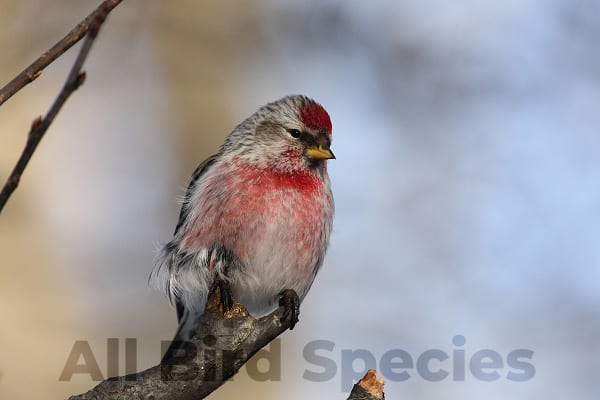
Physical Description
This small finch has brownish-grey feathers and a striking red forehead, which gives it a charming look. Its underparts are lighter, with streaks on the sides.
Males have richer colors than females, making them even more attractive. They have a compact body and a special conical beak. This beak is perfect for eating seeds, especially from birch trees.
Behavior and Social Interaction
Watching the Common Redpoll is a joy. They are very social and love to forage in groups. Their chatty nature brightens up our winter days.
They play and interact while eating, showing off their social hierarchy. In winter, they migrate to Michigan, where they add color to our birdwatching adventures.
4. Hoary Redpoll
- Scientific Name: Acanthis hornemanni
- Size: 12–14 cm (4.7–5.5 in)
- Weight: 14–19 g (0.49–0.67 oz)
- Lifespan: Up to 5 years
- Diet: Seeds, especially from birch and willow
The Hoary Redpoll is a rare sight that birdwatchers love. They are lucky to see this beautiful bird. Knowing how to spot them helps us enjoy their uniqueness in Michigan.
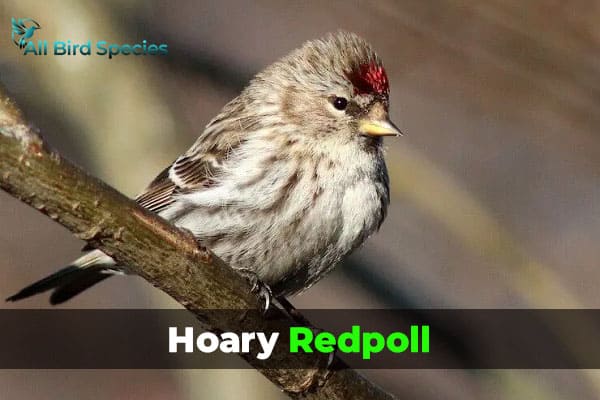
Appearance and Identification
The Hoary Redpoll has a special look. They have pale colors that match their winter home. Their soft feathers look white or light grey, hiding them in the snow.
They have a black cap and rosy red on their chest. This makes them stand out.
In summer, they hide in thick plants. They eat seeds and buds, showing they can adapt. Their migration is unpredictable, making them rare in Michigan. Sometimes, they visit our yards in winter, bringing beauty to the cold.
5. Red Crossbill
- Scientific Name: Loxia curvirostra
- Size: 16–20 cm (6.3–7.9 in)
- Weight: 16–28 g (0.56–0.99 oz)
- Lifespan: Up to 8 years
- Diet: Seeds from conifer cones
The Red Crossbill is special among finches. Its crossed bill helps it get seeds from conifer cones. This finch lives in certain places and shows us how finches adapt and what they need to live.

Unique Adaptations
The Red Crossbill can really adapt to its home. Its strong, crossed bills let it open conifer cones. This gives it food that other birds can’t get.
These birds change how they nest based on food. When food is scarce, they might breed less or live in different places. This shows they can adjust to different situations. They need mature forests to survive, so we must protect these areas.
6. White-Winged Crossbill
- Scientific Name: Loxia leucoptera
- Size: 16–18 cm (6.3–7.1 in)
- Weight: 16–22 g (0.56–0.78 oz)
- Lifespan: Up to 10 years
- Diet: Seeds from conifer cones
The White-Winged Crossbill is known for its unique wing markings and bill shape. It plays a special role in Michigan’s bird world. Its conservation status shows the challenges it faces.

This bird likes certain habitats, which affects its range in North America.
Conservation Status and Range
The White-Winged Crossbill’s conservation status is complex. Changes in its habitat, especially in pine forests, are noted. These birds need lots of conifer seeds to survive.
Changes in their population are linked to habitat changes. Threats like forest management, climate change, and urban growth are big concerns. Conservation efforts aim to protect their habitats and ensure their survival.
| Factors Influencing Conservation Status | Impact on Habitat Range |
|---|---|
| Forest Management Practices | Reduction in suitable breeding habitats |
| Climate Change | Altered food availability and migration patterns |
| Urban Development | Fragmentation of natural habitats |
| Invasive Species | Competition for resources |
7. Evening Grosbeak
- Scientific Name: Coccothraustes vespertinus
- Size: 18–21 cm (7–8.3 in)
- Weight: 40–50 g (1.4–1.8 oz)
- Lifespan: Up to 15 years
- Diet: Seeds, fruits, buds
The Evening Grosbeak is loved for its bright yellow and black feathers. It eats big seeds and fruit. Its special bill lets it get seeds that others can’t.

In Michigan, these birds come in winter from their summer homes. They might not always be here, but bird lovers look forward to seeing them. They often show up in big numbers during the cold months.
Spotting an Evening Grosbeak is easy because of its bright colours and strong body. Watching them eat seeds is a fun thing to do for bird fans.
| Feature | Description |
|---|---|
| Coloration | Vibrant yellow body with black wings and a distinctive black cap |
| Feeding Habits | Primarily feeds on seeds, particularly from conifers and fruit-bearing trees |
| Habitat Preference | Prefers coniferous forests and suburban areas with larger trees |
| Migration | Winter visitors in Michigan, sometimes appearing in flocks |
8. Pine Grosbeak
- Scientific Name: Pinicola enucleator
- Size: 20–25 cm (7.9–9.8 in)
- Weight: 70–100 g (2.5–3.5 oz)
- Lifespan: Up to 10 years
- Diet: Seeds, berries, fruits
The Pine Grosbeak is a striking bird known for its vibrant colour and size. It’s a favourite among birdwatchers. These birds have distinctive physical features that make them stand out.
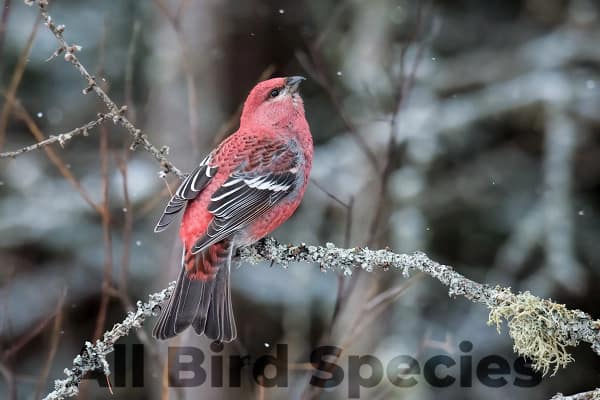
Their broad, sturdy bodies and striking plumage offer a visual treat. They are often spotted in forests or at backyard feeders during the colder months.
Differentiating Features
The Pine Grosbeak’s physical features are quite remarkable. Adult males have bright red or pink hues on their heads and backs, while females have more subdued yellow and olive tones.
Their robust bills are designed for cracking seeds, adding to their unique appearance. Their size and colouration make them easily identifiable in the wild.
Feeding Preferences
The diet of the Pine Grosbeak primarily consists of fruits and seeds. They love the berries from mountain ash and other tree fruits, which help in seed dispersion.
During winter months, we can observe them feeding in flocks. They forage amongst the trees or visit feeders. Their feeding habits benefit their survival and add to the vibrant life of their habitats.
9. Pine Siskin
- Scientific Name: Spinus pinus
- Size: 11–12.5 cm (4.3–4.9 in)
- Weight: 9–19 g (0.32–0.67 oz)
- Lifespan: Up to 5 years
- Diet: Seeds, especially from conifers and weeds
The Pine Siskin is a small but lively finch known for its social behavior and streaked feathers. Watching it shows how it works together to find food.
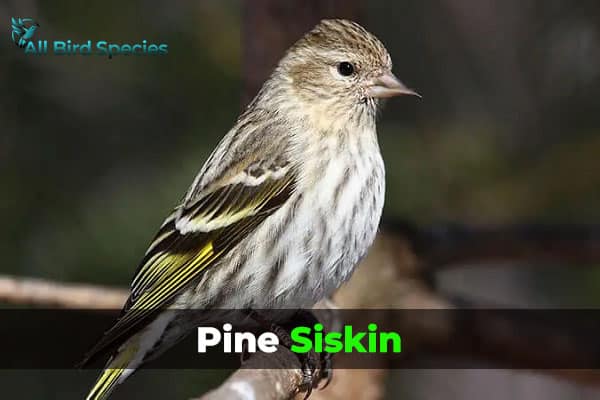
Social Behavior
In groups, the Pine Siskin shows how adaptable it is. At bird feeders, we see them with other birds. They work together to find food, which helps them survive.
They love seeds, especially sunflower seeds and thistle. Within their groups, they have a pecking order. This helps them avoid fighting over food, making their interactions fun to watch.
The Pine Siskin is a migratory bird with interesting group dynamics. They return to the same spots to eat and breed. Watching them can make birdwatching even more enjoyable.
Finches in Michigan: Birdwatching Tips
Knowing the best places to spot finches in Michigan enhances the experience for those of us passionate about observing them. We can find a variety of finch viewing locations that cater to birdwatching enthusiasts of all levels. Alongside optimal viewing spots, we also recommend effective setups for attracting finches to our backyards, allowing us to enjoy their presence up close.
Best Locations for Viewing
- Harris Nature Center in Meridian Township: This beautiful preserve offers ample opportunities to see house and purple finches.
- Wetlands of the Kalamazoo River: A vital habitat for various finch species, the wetlands provide perfect conditions for birdwatchers.
- The Mackinac Island State Park: Known for its scenic views and diverse wildlife, this location sees many finches during migration seasons.
- Port Huron State Park: This park features numerous trails ideal for spotting siskins and crossbills.
Feeding Recommendations for Backyard Birding
Setting up backyard bird feeders may attract finches right to our homes. To ensure a successful experience, consider the following tips:
| Feeder Type | Seed Types | Target Species |
|---|---|---|
| Sock Feeders | Niger Seed | Pine Siskins, Goldfinches |
| Platform Feeders | Mixed Seeds | House Finches, Purple Finches |
| Hopper Feeders | Safflower Seeds | Evening Grosbeaks |
Read More🐦Related Articles:
| Finches In Hawaii |
| Spiders in California |
| Hawks in Tennessee |
| Green Birds in Sarasota Florida |
| Small Birds with Long Tails |
Conclusion
The variety of finch species in Michigan shows us the beauty of birds. Each finch has its own special traits and ways of acting, making us see how amazing nature is.
From the House Finch to the Pine Grosbeak, these birds bring joy to birdwatching. They teach us about our local wildlife.
We should all try birdwatching and use this guide to learn more about finches. Watching them in our yards or in the woods makes us appreciate nature more.
By loving finches in Michigan, we also help protect their homes. Let’s work together to keep their habitats safe so that future generations can enjoy seeing finches.



